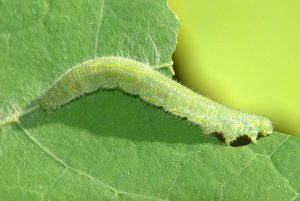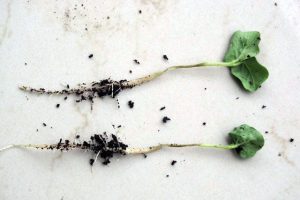Cabbages are a good source of income for many Zambian farmers and care should be taken to ensure that they are well cultivated and farmers find humble time to take good care of them by simply attending to them and ensuring that they are prevented from major disease infections. The growth of cabbage is however inhibited by the attack of the following major pest and diseases.
Aphids
Aphids are red black, green or white insects that cause leaves to become curled yellow and release a honeydew substance.
To control alphids, use a strong stream of water, insecticidal soaps or pesticides such as Sevin or Diazinon. You can also place a layer of aluminum foil under plants to reflect light to underside of leaves causing them to become an undesirable habitat for aphids.

Cabbage worms or loopers
Loopers are caterpillars that are usually greyish or green. They normally take on the color of the host plant which makes them blend well and be difficult to see. After a period of time, they develop into yellow or white-winged butterflies. These caterpillars often feed underneath of leaves which leaves ragged holes sometimes to the extent that cabbage leaves starve and die.
To control loopers, spray with Bacillus thuringiensis (Bt) which you can find commercially as Thuricide or Dipel. Try to cover leaves with row covers during the months from August to October.

Black Rot (Xanthomonas campestris pv. campestris)
This bacterial disease is common during the rainy season. The leaves become infected during any growth stage and the symptoms resemble nutritional deficiencies. when seedlings are infected, they drop lower leaves, become yellow and can die. The leaves normally become affected on only one side of a seedling. If your plants are infected because of contaminated seed, you may not see symptoms for a couple of weeks. The main symptom of black rot is caused by local infection that comes about when bacteria enter leaves through natural openings of leaf margins. The tissue then turns pale green-yellow and then turns brown and dies.
You can spot affected areas from the wedge- or V-shaped. These areas get bigger as the disease spreads, and badly affected leaves eventually fall off. The veins in infected stems, leaves and roots also sometimes become black. The heads also remain small and the quality of the cabbage reduces making it unfit for marketing.
To control black rot, use black rot tolerant varieties to help control the disease. You can considerably reduce the disease, when you treat seeds with Streptocycline (100 ppm) or Agrimycin-100 (100ppm). Furthemore, plant on raised beds to facilitate drainage. You should also avoid cultivating in fields where crucifers have been continuously grown during last 2 years. Thoroughly inspect plants for black rot symptoms and remove and destroy all the affected plants.

Downy Mildew (Perenospora parasitica)
High humidity and drizzling rains favour the disease development and spread. The first symptom you’ll observe are small, light green-yellow lesions on the upper leaf surface. These later show on the undersurface. The spots start to turn yellow as the leaves enlarge. During periods of high humidity, a grayish white moldy growth develops on the undersurface of the leaf. Later the leaf becomes papery and dies. Cabbage heads often have sunken black spots. However, some plants get infected at the seedling stage, with symptoms only becoming visible near harvest time.
To control Downy Mildew, destroy all weeds serving as alternate host to the fungus. Irrigate the crop judiciously to avoid periods of high humidity. Spray seedlings with Copper Oxychloride (0.3%) to effectively control the disease. Give the first spray as soon as the seedlings appear. You can give subsequent sprayings at weekly intervals until the plants are transplanted in the field. To control the disease in the field, spray the crop with Copper Oxychloride (0.5%).

Damping off (Pythium debaryanum)
Damping off can cause severe damage in the nursery. High humidity, cloudy weather, wet soils, compacted soil, and overcrowding can bring about the development of damping-off. The disease kills seedlings before or soon after they sprout. Infection before sprouting causes poor germination. If the infection is after the seedlings emerge, they fall over or die which is called “damp-off.” The damage the disease causes depends on the amount of pathogen in the soil as well as on environmental conditions. Seedlings that sprout develop a lesion near where the tender stem is in contact with the soil surface. The tissues underneath the lesion becomes soft causing the seedlings to collapse.
To control damping off, in the nursery, use well- drained soil for preparing raised beds. Avoid excessive irrigation to reduce humidity around the plants. Seed treatment with antagonist fungal culture of Trichoderma viride (3-4 g/kg of seed) or Thiram (2-3 g/kg of seed) and soil drenching with Dithane M 45 (0.2%) or Bavistin (0.1%) affords protection against the disease. You should regularly inspect the nursery for the disease affected seedlings and remove/destroy such seedlings


DEAR sir/madam am kindly asking for a full pdf of cabbage guideline i am a small scale farmer who wants to start growing cabbages your help will be highly appreciated.
Goodmorning Sir/Madam,
I would like a downloadable document on how to grow cabbage successfully. We are using the backyard as a learning process to grow vegetables this before we move to a bigger land next year.
Nice info on this page. Appreciate it.
Wonderful your guide has given me a clear insight in identifying black rot at early stages especially in leaves.I really appreciate.
[…] Related Article: Managing Cabbage Pests and Diseases […]
help me with the full control documents of how to mange cabbages from pest and disease pdf
[…] You can control cabbage moth caterpillars and butterflies with organic insecticides. Black leg fungus can cause the stem of the cabbage to turn black at the level of the soil. Use an organic fungicide and remove the adjacent soil away. If this doesn’t work, you may have to remove the crops. Black leg fungus can stay in the soil for several years, so avoid planting cabbages or cauliflowers in the affected area for atleast two seasons. For more information on cabbage diseases, click here […]
[…] Please read this article: Managing cabbage pests and diseases […]